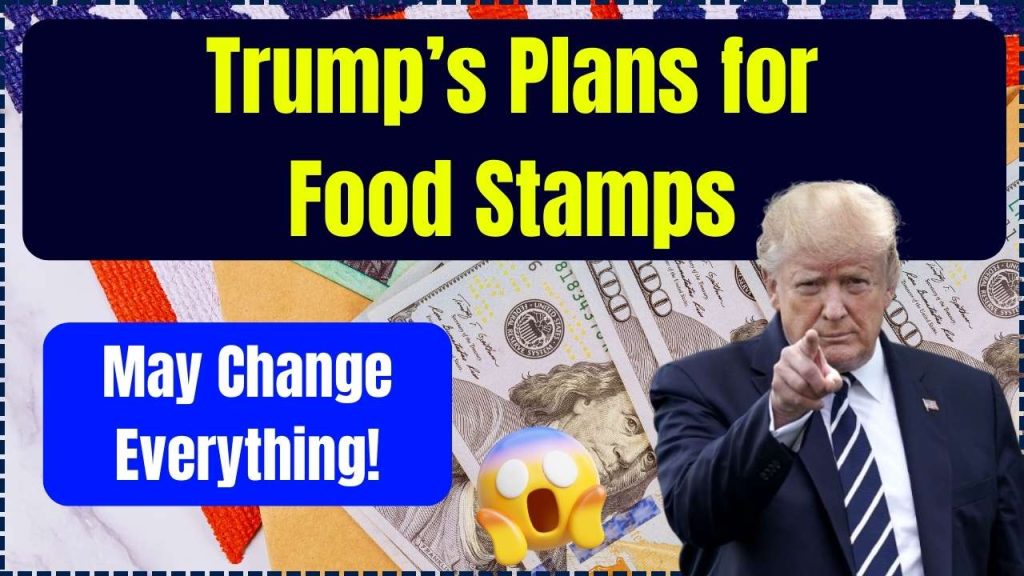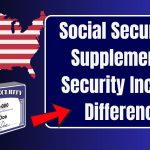Trump’s Plans for Food Stamps: The Supplemental Nutrition Assistance Program (SNAP), commonly known as food stamps, plays a crucial role in supporting millions of low-income individuals and families across the United States. As discussions around potential policy changes continue, many Americans are concerned about the future of SNAP.
Former President Donald Trump’s proposals during his administration sparked widespread debate, with suggested changes that included budget cuts and stricter eligibility requirements, aiming to reduce federal spending on SNAP.

This article dives into SNAP’s current status, Trump’s historical proposals, potential future changes, and what they could mean for SNAP recipients and the broader community. Whether you’re a SNAP recipient, a policy professional, or someone interested in food security, understanding these potential changes is essential.
Trump’s Plans for Food Stamps
| Key Highlights | Summary |
|---|---|
| SNAP Overview | SNAP, or Supplemental Nutrition Assistance Program, is a federal aid program supporting low-income individuals and families with food assistance. |
| Trump’s Proposed Changes | Trump’s administration previously proposed tighter eligibility, stricter work requirements, and budget cuts to reduce federal spending on SNAP. |
| Potential Risks | Changes could reduce the number of recipients, increase food insecurity, and shift financial responsibility to individual states, leading to uneven SNAP benefits across the U.S. |
| Current Status | SNAP remains unchanged as of November 2024, but political changes could bring back Trump-era proposals. |
| How to Prepare | Staying informed, reaching out to local representatives, and understanding eligibility can help individuals and communities prepare for possible changes. |
| Visit SNAP Official Site | For more information and eligibility criteria |
The future of SNAP remains uncertain, especially if Trump-era proposals are revisited. With potential changes to eligibility, funding, and benefit amounts, many Americans may worry about the impact on their food security. However, by staying informed, engaging with local representatives, and proactively understanding eligibility, individuals and families can be better prepared for any possible changes in SNAP policy.
What Is SNAP, and Why Is It Important?
SNAP is the largest federal nutrition assistance program in the U.S., supporting low-income individuals and families by helping them purchase food. For millions, SNAP is a lifeline, reducing food insecurity and improving access to nutritious meals. The program operates on a federal level but is managed by state agencies, with eligibility determined based on income, family size, and other factors.
During economic downturns, SNAP becomes especially important. During the COVID-19 pandemic, for instance, SNAP enrollment surged as many Americans lost their jobs or experienced reduced hours. The Center on Budget and Policy Priorities (CBPP) reports that SNAP currently supports over 42 million Americans, including children, seniors, and people with disabilities (CBPP SNAP Data).
Trump’s Proposed Changes: A Historical Perspective
During his presidency, Donald Trump introduced several policy changes aimed at reducing SNAP costs. These proposals brought about debate, with concerns about how they could affect recipients and the potential for increased food insecurity. Let’s examine some of Trump’s key proposals and their potential implications.
1. Stricter Work Requirements
One of Trump’s most significant proposals was to enforce stricter work requirements for SNAP recipients, particularly for “able-bodied adults without dependents” (ABAWDs). The proposed rule required ABAWDs to work or participate in job-training programs to maintain their SNAP benefits, limiting their eligibility to just three months over three years if they did not meet the requirements.
This rule, had it gone into full effect, could have led to over 700,000 people losing access to SNAP benefits, according to CBS News (CBS News on SNAP Cuts). The measure faced significant pushback and was ultimately blocked by a federal judge in October 2020.
2. Budget Reductions and State-Level Shifts
In his 2018 budget proposal, Trump suggested major budget cuts to SNAP and proposed shifting some of SNAP’s financial responsibility to individual states. Under this plan, states would need to provide more funding, resulting in a patchwork of SNAP policies where the level of support would vary widely across the country. States with tighter budgets might struggle to match federal funding, potentially affecting the program’s stability and efficiency.
3. Asset Testing
The Trump administration also considered reinstating stricter asset tests for SNAP eligibility. An asset test examines a household’s total resources, including cash savings, property, and other assets. Households with assets above a certain threshold could be disqualified from receiving benefits. This would particularly impact individuals who have minimal savings or assets but still struggle with food security due to low income or high living costs.
Could SNAP Be at Risk Again? Analyzing Potential Threats
With the possibility of these policies returning in future political climates, SNAP faces potential risks that could significantly impact millions of families. Here are three potential threats and their likely consequences on food security and community well-being.
Potential Threat #1: Stricter Eligibility and Asset Requirements
Should stricter eligibility and asset requirements be reinstated, many households currently eligible for SNAP could lose access to benefits. For example, a family with modest savings for emergencies might suddenly find themselves ineligible, leaving them in a precarious position during times of economic uncertainty.
Potential Threat #2: State-Level Responsibility and Funding Shifts
Shifting more SNAP funding to individual states could result in unequal access across different states. States with tight budgets may reduce SNAP benefits, resulting in a weaker safety net for low-income families. Such discrepancies would increase regional inequalities, leaving families in certain areas with significantly less assistance than others.
Potential Threat #3: Reduced Monthly Benefit Amounts
If states face challenges in funding, monthly SNAP benefit amounts could decrease, impacting recipients’ ability to purchase adequate food. According to the United States Department of Agriculture (USDA), the average monthly SNAP benefit is already modest, covering only part of a household’s food needs (USDA SNAP Data). Lowering this amount could exacerbate food insecurity and increase demand on food banks and community resources.
Prepare for Potential Changes to SNAP
For those relying on SNAP or working in fields impacted by food assistance policies, here’s a practical guide to prepare for potential SNAP policy changes. Staying informed and planning ahead can make a difference.
Step 1: Stay Informed and Engage
Keeping up-to-date on proposed legislation and policy changes can help you anticipate shifts in SNAP’s structure. Follow reliable sources, such as USDA, CBPP, and major news outlets for the latest developments. Engaging with community organizations can also keep you informed of upcoming changes.
Step 2: Connect with Local Representatives
Reaching out to local or state representatives can help you express your concerns about SNAP changes. Lawmakers often consider constituent input when making decisions. Additionally, you may learn about local resources or state policies that support food security initiatives.
Step 3: Understand and Monitor Eligibility
Reviewing eligibility criteria periodically is essential, especially if changes are proposed. Knowing if stricter requirements or asset tests are in place can help you stay compliant. If work requirements return, consider participating in job training programs to secure ongoing eligibility.
Step 4: Build a Community Network for Support
Forming connections with food banks, community groups, and advocacy organizations can provide support if SNAP benefits decrease. Local resources like food pantries, community gardens, or meal programs can be invaluable for those facing food insecurity.
Step 5: Consider Emergency Savings or Budget Adjustments
If you rely on SNAP, building a small emergency fund can provide a buffer in case benefits are reduced or eligibility requirements change. Budget adjustments, including prioritizing essential expenses, may also help if your SNAP benefits decrease in the future.
Social Security November Payment Update For Pre-1997 Retirees: Check Eligibility and Process
$1,600 Relief Package Coming In November For this State: Know Eligibility & Application
$16,800 Expense Payment Aid Only For These Americans In November 2024: Check How to get it
FAQs On Trump’s Plans for Food Stamps
Q1: What is SNAP?
SNAP, or Supplemental Nutrition Assistance Program, is a federal aid program that provides food assistance to low-income individuals and families. SNAP benefits are delivered through an Electronic Benefits Transfer (EBT) card that can be used to buy groceries at participating retailers.
Q2: Why did Trump propose changes to SNAP?
Trump’s proposed changes aimed to reduce federal spending and encourage able-bodied adults to find employment. Critics argued that these policies would increase food insecurity and disproportionately affect vulnerable populations.
Q3: How might SNAP budget cuts impact states?
If states are required to cover more of SNAP’s funding, some might struggle to provide the same level of benefits, especially during economic downturns. This could lead to reduced benefits and eligibility, particularly in low-income or high-cost states.
Q4: How can individuals prepare for potential SNAP changes?
Staying informed about policy developments, connecting with local representatives, and understanding eligibility requirements can help. Additionally, building a support network and creating a small emergency fund can provide backup if benefits are reduced.
Q5: Where can I find reliable information on SNAP?
For official information, eligibility requirements, and application processes, visit the USDA SNAP official site.

